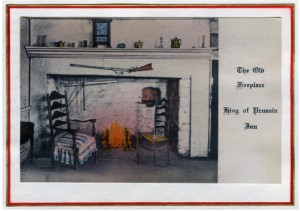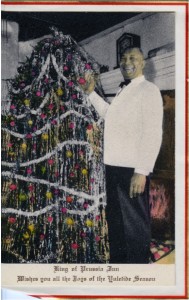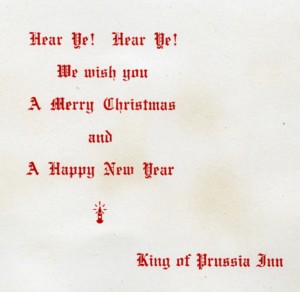The early settlers of Upper Merion Township celebrated Christmas with a colorful blend of customs and traditions brought over from the old country.
The Swedes began their Christmas celebration with the feast of St. Lucia, the patron saint of Sweden, on December 13. However, on Christmas morning, they gathered in Christ Church, Swedesburg, where the minister opened the service announcing to the congregation, “Today, in the City of David, is born a Saviour, Jesus the Lord, let us adore Him.” And the people responded, “Glory to God in the highest, and on earth peace, goodwill toward men.” This then was followed by the liturgy of the Swedish Lutheran rite. After the service, the Swedes would meet in their houses for meals, inviting their neighbors and Indian friends.
The early English and Welsh settlers of Upper Merion brought over a curious observance during Christmas time called “The Kissing Bunch,” which consisted of a tree branch laced with wooden hoops. These were covered with evergreen boughs and hung from the ceiling. Inside the hoops were the figures of Mary, Joseph, and the Christ child. From the bottom of the kissing bunch hung a sprig of mistletoe.
Christmas was a special holy day for the early Irish immigrants of Swedesburg and Cudgeltown. Most of the Irish walked to St. Patrick’s church in Norristown from Swedesburg and those in Cudgeltown, used John Brooke’s quarry carts to attend Mass. After Mass, the Irish gathered in their homes for dinner and singing.
Polish settlers came to Upper Merion in the 1880’s and for them Christmas combined three important attributes, religion, family and country. The observance of the Christmas Eve Wigilia or supper sharing the peace wafer (oplatek) made for an unforgettable experience in family togetherness, culminated with the midnight Mass (pasterka) in Sacred Heart Church, Swedesburg, and the singing of Christmas carols (Kolendy).
The Germans of Upper Merion observed Christmas Eve with the anticipation of the coming of the Christ child Kristkindlein who would visit the children bearing gifts. But also, there was Pelznichol who was known to punish unruly children. The Germans observed a ritual called Kindelweige, a traditional practice of “rocking a cradle with baby Jesus” as they sang, “Let us rock the little Child and bow our heads before the crib.”
The Slovaks and Hungarians lived mainly around the Swedeland area of Upper Merion. They observed Christmas with great reverence. On Christmas Eve they exchanged the peace wafer (oplatky) followed by a traditional fish dinner with a toast of slivovica, plum brandy or krunik, a honey-spiced vodka. The evening concluded by attending Midnight Mass. The Slovaks were well known for their baking of the piernik, a ginger cake and a poppyseed bread pastry.
The Italians of Upper Merion were part of the group of immigrants who built the Philadelphia and Western Railroad (P&W) from 69th Street to Norristown, settling along its route. A very religious people, the Italians placed nativity sets (presepio) in front of their homes and went house-to-house caroling and playing on bagpipes “canzone di Zampognart“, the carols of the bagpipers.
From the article, Christmas Was Observed With Great Reverence in Early Upper Merion, by Ed Dybicz
PHOTOS: Christmas greeting cards sent by the owners of the King of Prussia Inn to their loyal clientele, were very popular keepsakes from the 1940’s. (Courtesy of Jimmy Kerr.)



